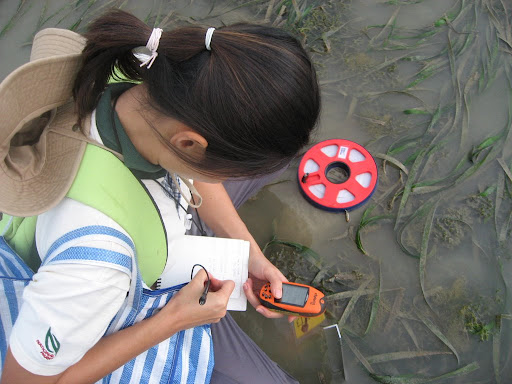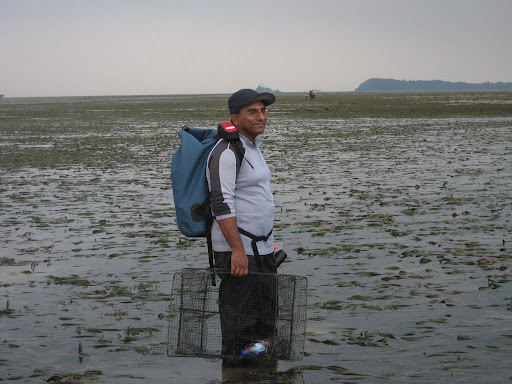After an early morning start, we are divided into two teams. Here's Team A all raring to go, although it looks like Siti is stifling a yawn? :-)
 Team B had to walk a longer bit out to the northern bar. But they certainly are bright and awake!
Team B had to walk a longer bit out to the northern bar. But they certainly are bright and awake! Everyone quickly got down to monitoring and it was soon done!
Everyone quickly got down to monitoring and it was soon done!
 We spent the rest of the low tide exploring Chek Jawa.
We spent the rest of the low tide exploring Chek Jawa.It was Slug Season! There were zillions of Hairy sea hares (Bursatella leachii)!! It was almost impossible to walk without squashing them, so we had to be VERY careful. In some places, they gathered in writhing masses.
 The hairy sea hare (left) has delicate blue spots and seems to be seasonal. I've seen them in huge numbers for a few weeks and never again for the rest of the year. There was also another kind of sea hare (right) that was smooth. Still not really sure what this is, but I've seen this also on our Southern shores.
The hairy sea hare (left) has delicate blue spots and seems to be seasonal. I've seen them in huge numbers for a few weeks and never again for the rest of the year. There was also another kind of sea hare (right) that was smooth. Still not really sure what this is, but I've seen this also on our Southern shores. The weirdest Find of the Day was this Unidentified Worm.
The weirdest Find of the Day was this Unidentified Worm. At first glance, I thought it was a very large peanut worm. But a closer look clearly shows that it wasn't one. It had this strange spoon-like structure at one end.
At first glance, I thought it was a very large peanut worm. But a closer look clearly shows that it wasn't one. It had this strange spoon-like structure at one end.When I got home, quickly flipped through my invertebrate bible and lo and behold! It's probably an echiuran or spoon worm. A spoon worm has a spoon-thing, called a protomium, is found in front of the mouth and is not retractible. The protomium can extend up to 10 times its retracted length, in some species, reaching 2m long! In most, the protomium is used to gather edible bits from the surface.
 Many live in U-shaped burrows in shallow water, others in rock or coral crevices. Apparently, echiurans may be important food for some fishes. In a study of Leopard sharks off California, large, meaty spoon worms were found to be their favourite food.
Many live in U-shaped burrows in shallow water, others in rock or coral crevices. Apparently, echiurans may be important food for some fishes. In a study of Leopard sharks off California, large, meaty spoon worms were found to be their favourite food.Here's a drawing of a burrowing echiuran called the Landlord worm found in the U.S. east coast (Taken from Barnes' Invertebrate Zoology). Apparently, its burrow is so comfy that tiny clams and crabs quickly settle in with the worm.
I wonder what our spoonworm does? Lots more to find out about our shores!
Today, TeamSeagrass had a special treat as Dr Dan and his students from Duke University joined us. Dr Chua Ee Kiam was also with us, fresh from completing his new book about our shores: Singapore's Splendours: Life on the Edge which was presented to Dr Dan and team.
 Ron kena arrowed to guide them again. He introduced Chek Jawa, and one of the students picked up Ron's chopstick approach from our last trip to Sisters Island with Dr Dan and gang. Dr Dan pointed out mating hermit crabs and other interesting happenings on the shores.
Ron kena arrowed to guide them again. He introduced Chek Jawa, and one of the students picked up Ron's chopstick approach from our last trip to Sisters Island with Dr Dan and gang. Dr Dan pointed out mating hermit crabs and other interesting happenings on the shores. Ron managed to show them a few carpet sea anemones and several species of sea cucumbers that survived the recent mass deaths. Dr Dan also did a thorough check on the shore and shared his insights on his all-new 'Dr Dan in Singapore' blog in an entry entitled: Will Chek Jawa Rebound?
Ron managed to show them a few carpet sea anemones and several species of sea cucumbers that survived the recent mass deaths. Dr Dan also did a thorough check on the shore and shared his insights on his all-new 'Dr Dan in Singapore' blog in an entry entitled: Will Chek Jawa Rebound?The Duke students documented the entire trip; from the bumboat, to the van, and all the habitats on Chek Jawa! They have also set up a blog about their Singapore stay: Duke students in Singapore. There's interesting comments there about durians, NEWater and other quirky Singapore things. They've called themselves the Ais Kachang gang!
After the trip, everyone lent a hand washing up the metres and metres of tape. It was done in a few minutes! This is a great help as otherwise, poor Shufen and Weiling have to spend hours washing up all the tape. Andy suggested we use a bucket next time to save water. A great idea!
Famished, we hopped back to Changi and hunkered down to lunch. Everyone introduced the students to some Lunar New Year raw-fish and chilli crab!
More photos and stories about our day out on the wildfilms blog by Cynthia (who was literally left holding the bags as the rest of the wildfilms crew were arrowed for other jobs today. Apologies once again Cynthia).
More about the hit-and-'Ron' fish on Ron's tidechaser blog as well as more about his time with Dr Dan and gang. And Dickson shares his encounters on the blue heaven blog. While Mr Budak shares a more poignant view of Chek Jawa on his budak blog
The day before, some of us went down to reset the monitoring markers.
 Siti, Wei Ling and Shufen worriedly examined the rather sad state of the Ribbon seagrass (Cymodocea rotundata). These seagrasses are now rather skinny and sparse, following the recent mass deaths.
Siti, Wei Ling and Shufen worriedly examined the rather sad state of the Ribbon seagrass (Cymodocea rotundata). These seagrasses are now rather skinny and sparse, following the recent mass deaths.But we found lots of the special tiny rare seagrass (Halophila beccarii) near the Team A monitoring zone! No need to hike all the way to the north to find them! (Sorry Len and Rudi, for making you trudge all the way there during your last trip).
 You can see here, how tiny these special seagrasses are, compared to the more commonly encountered Spoon seagrass (Halophila ovalis).
You can see here, how tiny these special seagrasses are, compared to the more commonly encountered Spoon seagrass (Halophila ovalis).What a fabulous monitoring session we had!
Thank you Team Seagrassers: Andy, Jingkai, May Yee, Dickson, Faizah, Helen, Marcus, Vyna, Paula, Sheryl, Tze Chien, Sijie, Chay Hoon and Annabelle.
And Dr Dan and friends for coming along for the trip and making it extra special.
And Ron for guiding Dr Dan; Alvin and Cynthia for filming us; Dr Chua for photographing us and Mark from Ubin NParks for looking after us. Colin came to help with the pre-monitoring set up even though he had twisted his ankle, while Kevin took leave to help. And Wilson helped on monitoring day.
Thank you everyone! Couldn't have done it without all of you.
Looking forward to the next monitoring trip! Sign up for upcoming trips on the TeamSeagrass database!



















 (Shufen prays I don't decapitate her by accident)
(Shufen prays I don't decapitate her by accident) And recording the GPS reading of transect start and end points for future reference. Here, Wei Ling records the GPS reading at the start point...
And recording the GPS reading of transect start and end points for future reference. Here, Wei Ling records the GPS reading at the start point... While Shufen and CK make the end-point readings
While Shufen and CK make the end-point readings Andy does his version of a beach clean-up called "ridding Semakau of fish-traps"
Andy does his version of a beach clean-up called "ridding Semakau of fish-traps" Some of the old drift nets however, are really big and have pretty much become part of the landscape. The one on the left is overrun with algae, while the one on the right seems to be newly laid down.
Some of the old drift nets however, are really big and have pretty much become part of the landscape. The one on the left is overrun with algae, while the one on the right seems to be newly laid down.

 Some might say that when one gets overly excited by splitting fruits of seagrasses, its time to get out more. But seriously, how do you get more 'out' than this?
Some might say that when one gets overly excited by splitting fruits of seagrasses, its time to get out more. But seriously, how do you get more 'out' than this? And clearly, despite having to battle things that can injure and incapacitate you, cold amphibious landings, being stuck thigh deep in soft mud and trudging up and down a 2km stretch of seagrasses, we're still a smiley bunch :)
And clearly, despite having to battle things that can injure and incapacitate you, cold amphibious landings, being stuck thigh deep in soft mud and trudging up and down a 2km stretch of seagrasses, we're still a smiley bunch :) Hope to see you guys at Semakau soon! :)
Hope to see you guys at Semakau soon! :)



